 |
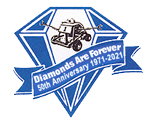 |
As
Diamonds Are Forever celebrates its 50th anniversary, KEVIN HARPER
takes a look back at the production of the seventh James Bond film, which saw
Sean Connery return to the role of 007 after a four-year absence. |
|
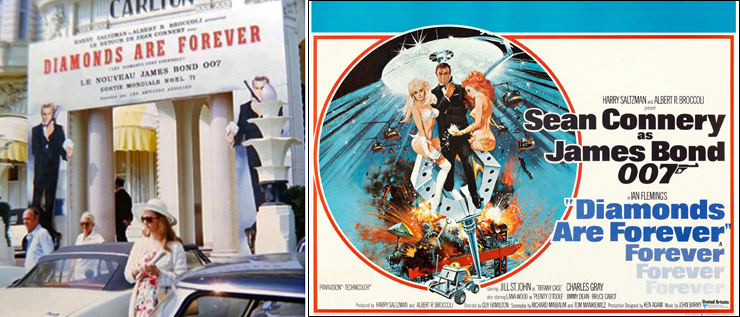 |
|
ABOVE: (left) YOU
ONLY LIVE TWICE? The worldwide Christmas release of Diamonds
Are Forever was promoted at the Carlton Hotel during the 24th
Cannes Film Festival 12-27 May, 1971. As no publicity material
featuring Sean Connery was yet available, the display used
illustrator
Yves Thos’ adaptation of the Robert McGinnis poster art from You Only Live Twice
(1967), replacing Bond's space helmet with a handful of diamonds.
(right) The final UK quad-crown poster also featured artwork by
Robert McGinnis; this was an amended version of his original
artwork and was altered to position James Bond's head and
shoulders higher than the two girls - earlier concept versions had
all three figures on the same level. |
|
|
|
Following the
disappointing box-office receipts for On Her Majesty’s Secret Service (1969)
when compared with the first five films in the series, and the less than
enthusiastic critical reception afforded newcomer George Lazenby,
distributor United Artists were keen to lure Sean Connery back to the role
which had made him an international star - and the studio a lot of money!
Believing their time with Connery was over and following the departure of
George Lazenby before On Her Majesty’s Secret Service had even hit
cinemas, James Bond producers Harry Saltzman & Albert R. Broccoli began a
search for another actor to play 007. Throughout 1970 they started looking for a new Bond and along
with director Guy Hamilton and associate producer Stanley Sopel, travelled
to the USA and even tested several American actors for the role including
Burt Reynolds (1936-2018). The clear favourite was
John Gavin (1931-2018),
best-known for playing Julius Caesar in Stanley Kubrick’s epic Spartacus,
and Sam Loomis in Alfred Hitchcock’s Psycho, both released in 1960. A
screen test was filmed at Universal Studios in November 1970, and after
negotiations Gavin was offered the role and signed a contract on January
29, 1971. Rumours of Gavin’s screen-test had begun to circulate in several
US newspapers in early 1971, and his casting was formally announced in the
press on February 10th. Filming on Diamonds Are Forever was
scheduled to begin in Las Vegas in
March 1971, and at this stage the seventh James Bond film was to be shot entirely
on location in America and at Universal City Studios in Hollywood. |
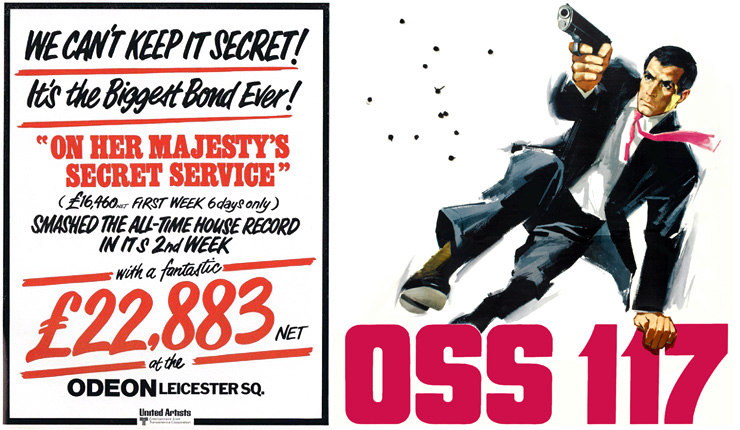 |
|
ABOVE: (left)
PREMIUM BOND - United Artists were proud to announce that On
Her Majesty's Secret Service (1969) had broken the all-time
house record at London's ODEON Leicester Square in its
second week of release. George Lazenby's only James Bond film was
far from being a failure on its original release, and went on to
become the most popular film of 1970 at the UK box-office. (right)
WOULD BE BOND - Poster artwork for the French/Italian 007 spoof
OSS 117 – Double Agent (1968) [also known as No Roses for
OSS-117], the fifth film in a series based on fictional secret
agent Hubert Bonisseur de La Bath created by the prolific French
author Jean Bruce. The first novel in the series Tu parles
d'une ingénue (Ici OSS 117) was published in 1949,
predating Ian Fleming’s CASINO ROYALE by four years. The previous
film in the series Tokyo pour OSS 117 (Terror in Tokyo)
released in 1966 and starring Frederick Stafford as OSS 117 (who
played the part twice), had an original screenplay by three-time
James Bond director Terence Young. In OSS 117 – Double Agent
(1968) John Gavin starred opposite future James Bond
villain Curt Jurgens [Stromberg in The Spy Who Loved Me
(1977)], and former Bond Bad-Girl Luciana Paluzzi [Fiona Volpe in
Thunderball (1965)]. Released in Europe at the tail-end of the spy boom spawned
by the success of the James Bond films, Gavin’s interpretation of OSS 117 was never shown theatrically in the United States,
although it no doubt contributed to his eventual casting as James
Bond in Diamonds Are Forever. |
|
|
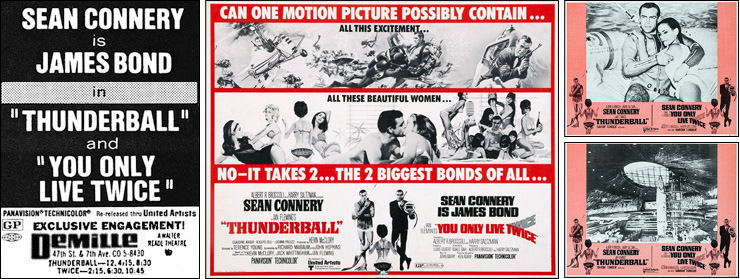 |
|
Distributor and financier
United Artists were still not convinced John Gavin was the right man for
the 007 role. Studio
head David Picker, who was involved with the casting of Sean Connery a
decade earlier, was sure that after the disappointing returns of On Her
Majesty’s Secret Service (1969), only one man could guarantee a box-office
smash. Thunderball/You Only Live Twice had just been re-released on a
double-bill in late 1970, and was the first time Sean Connery’s Bond films
had been seen in American cinemas for over a year. The pair played to
enormous success well into 1971 including an exclusive engagement at the
prestigious De MILLE theatre in New York’s Times Square, re-enforcing in
the public’s mind that Sean Connery was still James Bond. During the
16-months On Her Majesty’s Secret Service was on release in the UK, Sean Connery’s James Bond films were embargoed which obviously meant another
loss in revenue for the studio as they were out of circulation for an
extended period. The five Connery films had been more or less on constant release
individually or on double bills since the debut of Dr. No in October 1962. |
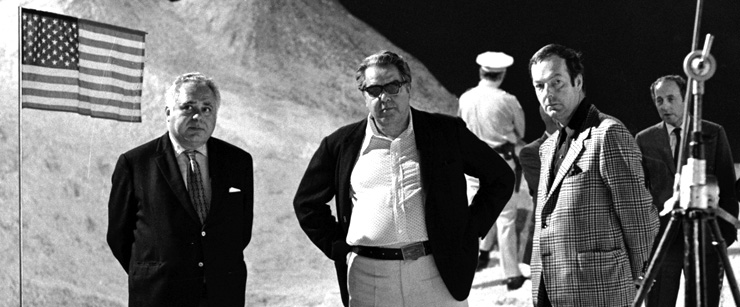 |
|
ABOVE: (L-R) Co-producers Harry Saltzman &
Albert R. Broccoli, four-time James Bond film director Guy
Hamilton, and associate producer Stanley Sopel on the moonscape
set at Pinewood Studios during the filming of Diamonds Are
Forever (1971). |
|
|
|
In February 1971 David Picker (1931-2019)
informed the James Bond producers that he would authorise the payment of a
huge salary to sign Sean Connery. Associate producer on Diamonds Are
Forever Stanley Sopel, and a personal friend of the star, was despatched
to meet him at the Dorchester Hotel in London. Since leaving Bond in 1967,
Connery’s career had faltered but he was still determined to make it on
his own and declined the offer to return to the Bond role, seeing it as a step backwards
and an admission of failure. Undaunted, Broccoli & Saltzman next asked
Ursula Andress, always Connery’s favourite Bond leading lady, to
personally persuade him to change his mind. When that didn’t work either, David
Picker decided to tackle the star himself and flew to London with an
unprecedented offer; a staggering basic fee of $1.25 million and a 10% cut
of the gross profits. Furthermore, Picker promised Connery that United
Artists would financially back, to the tune of one million dollars apiece,
any two films of his choosing; to either star in or direct. One of those
films turned out to be the gritty police drama
The Offence (1972), in
which Connery gave one of his best performances; the second project never
materialised. |
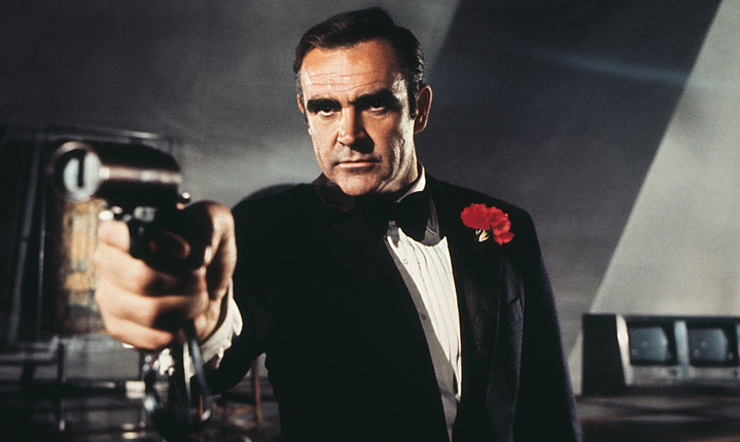 |
|
This was a deal too good
to refuse, though it still took Connery a week before finally accepting,
eventually earning himself a place in the Guinness Book of World Records
as the highest paid actor up to that time. “I was really bribed back into
it,” Connery admitted. “But it served my purpose.” In 1970 Connery had
joined forces with Scottish industrialist Sir Iain Stewart and racing
driver Jackie Stewart to create the Scottish International Educational
Trust, a charity that funded artistic individuals and worthwhile projects
in Connery’s homeland. To get the foundation moving and in sound financial
order Connery donated his entire fee to it from Diamonds Are Forever. In
addition to the upfront fee and percentage gross, Connery had a clause in
the contract that guaranteed an additional $10,000 per week if the film
overran its allotted 18-week shooting schedule. Needless to say filming
finished on time. With Connery back Diamonds Are Forever then
became an entirely different production. David Picker suggested that film
now become a British production in order to take advantage of the tax
rebate that could be recouped from the Eady Levy. Working on the
assumption that Connery’s return would result in a substantial hit at the
box-office, his unprecedented fee could be recouped and effectively cost
the studio nothing. The shooting schedule was revised, and now eight weeks
of location work in America would be followed by ten weeks at Pinewood
Studios and with a largely British crew. The Eady policy allowed half of
the ticket price for a film to be retained by the exhibitors, and the
other 50 was
divided among qualifying ‘British’ films in proportion to UK box-office
revenue. To qualify as a British film a minimum of 85% of the production
had to be shot in the United Kingdom or the Commonwealth, and only three
non-British individual salaries could be excluded from the costs of the
film, thereby ensuring employment of British actors, technicians and film
crew; this explains the use of several American actors playing smaller
roles who were already based in the UK, including
David Bauer (mortician
Morton Slumber of ‘Slumber Inc.’) already familiar from several British
films and television series,
and who had also appeared in a small role in You Only Live Twice (1967). |
|
CONTINUED |


